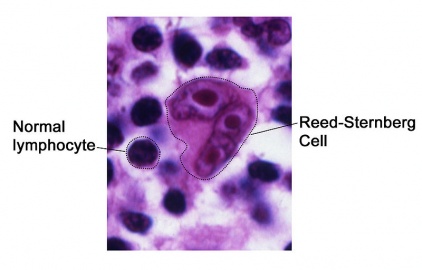Hodgkin's Lymphoma
Original Editors - Ann Bedwell from Bellarmine University's Pathophysiology of Complex Patient Problems project.
Lead Editors - Your name will be added here if you are a lead editor on this page. Read more.
Definition/Description[edit | edit source]
Hodgkin’s Lymphoma, also known as Hodgkin’s disease, is a “chronic, progressive, neoplastic disorder of lymphatic tissue characterized by the painless enlargement of lymph nodes with progression to extralymphatic sites such as the spleen and liver.”1 It may also metastasize to bone marrow and other organs.2 The sites initially affected are the lymph glands in the neck or groin, usually on one side.
This type of cancer is malignant and may travel to other parts of the body. As it progresses, it may compromise the body’s ability to fight infection since it is attacking the immune system.3
Hodgkin’s lymphoma is differentiated from other cancers and Non-Hodgkin’s lymphoma (connect to page) by the type of cell involved. The Reed-Sternberg cell is “part of the tissue macrophage system and have twin nuclei and nucleoli that give them the appearance of owl eyes.”4 There are two subtypes of Hodgkin’s lymphoma, classic and nodular lymphocyte-predominant. Classic Hodgkin’s lymphoma is further divided into four categories based on what the cell looks like under a microscope. These are Lymphocyte-rich classical Hodgkin lymphoma, Nodular sclerosis Hodgkin lymphoma, Mixed cellularity Hodgkin lymphoma, Lymphocyte-depleted Hodgkin lymphoma.5
Prevalence[edit | edit source]
In 2007, there were approximately 164,273 persons in the United States with a history of Hodgkin’s lymphoma. Based on rates from 2005-2007, “1 in 428 men and women will be diagnosed with Hodgkin lymphoma during their lifetime.”8
Incidence Rates by Race 8
| Race/Ethnicity |
Male |
Female |
| All Races |
3.2 per 100,000 |
2.5 per 100,000 |
| White |
3.4 per 100,000 |
2.7 per 100,000 |
| Black |
3.0 per 100,000 |
2.3 per 100,000 |
| Asian/Pacific Islander |
1.5 per 100,000 |
1.1 per 100,000 |
| American Indian/Alaska Native |
||
| Hispanic |
2.8 per 100,000 |
2.0 per 100,000 |
Hodgkin’s can occur in children and adults at any age, but peaks around age 25-30 years and after 55 years. Men are typically diagnosed with Hodgkin’s more than women. “Children younger than 5 years rarely develop this disease, while only 10% of HL cases occur in children 16 years old and younger.”4 The nodular lymphocyte-predominant Hodgkin’s lymphoma (LPHL), has a peak incidence around the fourth decade of life.
Approximately 7800 cases of HL are diagnosed in the United States each year.4
“Estimated new cases and deaths from Hodgkin’s lymphoma in the United States in 2010:
New cases: 8490
Deaths: 1320”6
Characteristics/Clinical Presentation[edit | edit source]
Signs:
- Painless, unilateral, enlargement of nymph node usually in the neck, underarm or groin1
• The lymph nodes should be examined based on the size, mobility, consistency and tenderness. A lymph node that is “over 1 centimeter in diameter and firm or rubbery consistency or tender are considered suspicious.”
• Lymph nodes that are soft and tender to touch are usually indicative of infection.
• Any changes in the shape, size, consistency, or mobility are red flags and should be reported to a physician immediately.
Symptoms:
- Fatigue
- Fever and chills that come and go
• Typically peaks in the late afternoon1
- Itching all over the body that cannot be explained
• Itching occurs mostly at night1
- Loss of appetite
- Soaking night sweats
- Painless swelling of the lymph nodes in the neck, armpits, or groin (swollen glands)
- Weight loss that cannot be explained
Other symptoms that may occur with this disease:
- Coughing, chest pains, or breathing problems if there are swollen lymph nodes in the chest2
- Excessive sweating2
- Pain or feeling of fullness below the ribs due to swollen spleen or liver2
- Pain in lymph nodes after drinking alcohol2
- Skin blushing or flushing2
- Malaise1
- Anorexia1
- Symptoms may occur due to the obstruction or compression of structures by the enlarged lymph nodes. This may cause edema in the neck, face or right arm due to blockage of the superior vena cava or renal failure from blockage of the urethra.1
- Obstruction of bile ducts results in liver damage or jaundice, which will present as a yellowish color to the skin
- “Mediastinal lymph node enlargement with involvement of lung parenchyma and invasion of the pulmonary pleura progressing to the parietal pleura may result in pulmonary symptoms, including nonproductive cough, dyspnea, chest pain and cyanosis.”1
- Nerve root pain and paraplegia could occur if the cancer spreads to the bones
- Invasion pericardium caused by enlarged “penetrating lymph nodes adjacent to the heart”4
- Hepatoslenomegaly4
Many of these signs and symptoms may be due to other health problems.
Associated Co-morbidities[edit | edit source]
add text here
Medications[edit | edit source]
add text here
Diagnostic Tests/Lab Tests/Lab Values[edit | edit source]
add text here
Etiology/Causes[edit | edit source]
add text here
Systemic Involvement[edit | edit source]
add text here
Medical Management (current best evidence)[edit | edit source]
add text here
Physical Therapy Management (current best evidence)[edit | edit source]
add text here
Alternative/Holistic Management (current best evidence)[edit | edit source]
add text here
Differential Diagnosis[edit | edit source]
add text here
Case Reports/ Case Studies[edit | edit source]
add links to case studies here (case studies should be added on new pages using the case study template)
Hodgkin's lymphoma masquerading as vertebral osteomyelitis in a man with diabetes: a case report
Hodgkin's lymphoma presenting with heart failure: a case report
Resources
[edit | edit source]
add appropriate resources here
Recent Related Research (from Pubmed)[edit | edit source]
see tutorial on Adding PubMed Feed
Failed to load RSS feed from http://eutils.ncbi.nlm.nih.gov/entrez/eutils/erss.cgi?rss_guid=1vY7UytnXUWxw5qAxf-ix7jiGCAAXR2mAklWeLMpG0s8LGf9fN|charset=UTF-8|short|max=10: Error parsing XML for RSS
References[edit | edit source]
see adding references tutorial.







